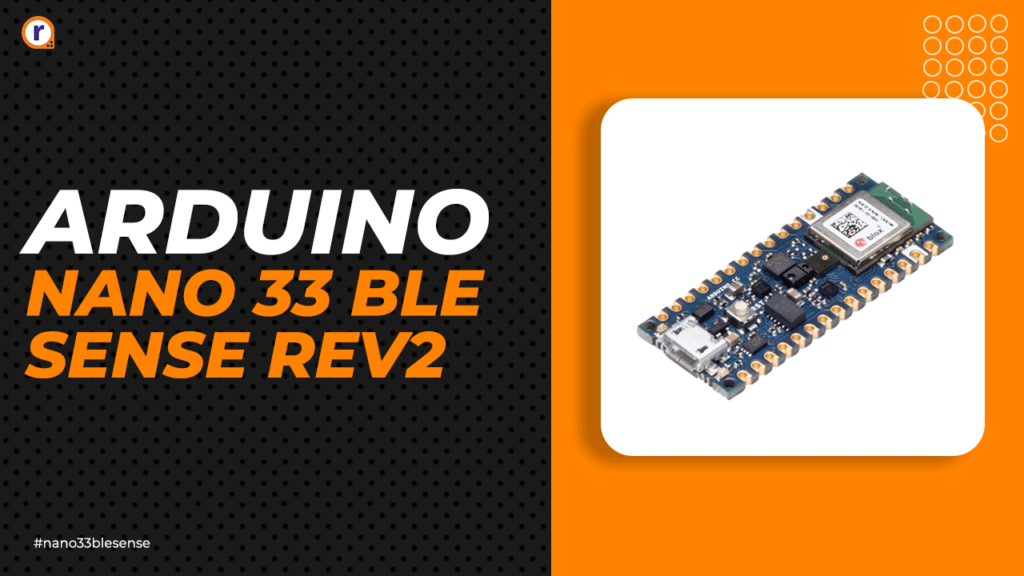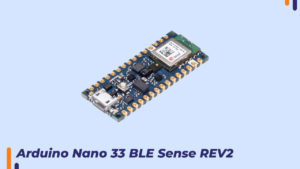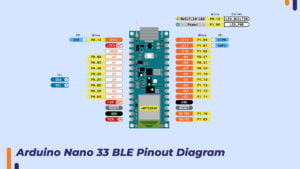Introduction Welcome to the blog post on the original Arduino Nano 33 BLE Sense Rev2. If you are an electronics enthusiast or hobbyist who wants to explore the world of

Introduction
Welcome to the blog post on the original Arduino Nano 33 BLE Sense Rev2. If you are an electronics enthusiast or hobbyist who wants to explore the world of microcontrollers, this is the right place. This article details the features and capabilities of the Arduino Nano 33 BLE Sense Rev2. We discuss technical specifications, explore possible applications and provide all the information you need to start your own project. So, let's embark on this exciting journey and unlock the potential of the original Arduino Nano 33 BLE Sense Rev2!
The Original Arduino Nano 33 BLE Sense Rev2 is a powerful microcontroller board that combines traditional Arduino features with cutting-edge features. Designed for Internet of Things (IoT) applications, this compact board offers a wide range of sensors and connectivity options. This makes it an ideal choice for projects requiring data collection, machine learning, and wireless communication capabilities. Unleash the power of the Arduino Nano 33 BLE Sense Rev2
The Arduino Nano 33 BLE Sense Rev2 is equipped with a 64 MHz ARM Cortex-M4 processor, providing plenty of computing power for your projects. 1MB flash memory and 256KB RAM provide enough space to store your code and perform complex calculations. Easily communicate with other devices and connect to the internet thanks to integrated Bluetooth Low Energy (BLE) and Wi-Fi connectivity.

Now We Explore Major-Tech Specifications
Let's take a closer look at the technical specifications of the original Arduino Nano 33 BLE Sense Rev2
Microcontroller: ARM Cortex-M4 (32-bit)
Clock frequency: 64MHz
Flash memory: 1MB
RAM: 256KB
Operating voltage: 3.3V
Digital I/O Pins: 14
Analog Input Pins: 8th place
PWM pins: Four
UARTs: 1
SPIs: 1
I2C: 1
ADC Resolution: 12 bit
Size: 45mm x 18mm
Experience a world full of sensors are compatible with
One of the standout features of the original Arduino Nano 33 BLE Sense Rev2 is the wide range of onboard sensors. These sensors allow you to collect data from your environment and create interactive projects. Let's take a look at some of the sensors available on this versatile board.
Accelerometer
A built-in accelerometer measures the acceleration acting on the board in three axes. This sensor is ideal for motion-based projects and gesture recognition applications.
Gyroscope
Gyroscopes allow you to measure angular velocity and rotation about three axes. This sensor is invaluable for projects involving orientation finding, stabilization, and virtual reality applications.
Magnetometer
A magnetometer allows you to measure the strength and direction of a magnetic field. This sensor is commonly used in compass applications and can also be used to detect the presence of nearby magnets.
Humidity sensor
Humidity sensors measure the relative humidity in the environment. Essential for projects that require environmental monitoring, such as weather stations and smart home automation systems.
Temperature sensor
A temperature sensor on the circuit board can be used to measure the ambient temperature. This sensor is suitable for applications such as temperature monitoring, environmental control, and thermal analysis. pressure sensor:
Air pressure can be measured with the built-in pressure sensor. This sensor is widely used in weather forecasting, altitude tracking, and drone applications.
Light sensor
A light sensor allows you to measure the intensity of ambient light. This sensor is useful for projects such as automatic lighting adjustments, energy-saving systems, and photography.
Gesture sensor
An integrated gesture sensor recognizes hand movements and gestures. This sensor is ideal for creating contactless interfaces, interactive installations, and robotics projects.
Microphone
Voice and audio data can be recorded with the built-in microphone. This sensor is commonly used in speech recognition, speech analytics, and home automation applications.
Color Sensor
The color sensor of the Arduino Nano 33 BLE Sense Rev2 can recognize various colors and convert them into digital values. This sensor is ideal for color detection, classification applications, and artistic projects.
Proximity Sensor
Proximity sensors detect the presence of nearby objects without physical contact. It is commonly used in applications such as gesture control, object recognition, and security systems.
Expanded connectivity options
The original Arduino Nano 33 BLE Sense Rev2 offers a wide range of sensors plus a variety of connectivity options for added versatility. Let's take a look at some of these connectivity features.
Bluetooth Low Energy (BLE)
Her BLE capability on the board enables wireless communication with other his BLE devices. This feature is essential for IoT applications, wearable devices and home automation systems.
Wireless Internet access
The built-in Wi-Fi connectivity makes it easy to connect the Arduino Nano 33 BLE Sense Rev2 to the internet. This opens up possibilities for cloud integration, remote monitoring, and data exchange.
USB interface
This board has a USB interface and can be connected to a computer for programming and data transfer. The USB interface also powers the board, eliminating the need for an external power supply in many cases.
Getting Started with Arduino Nano 33 BLE Sense Rev2
Having explored the features and functionality of his original Arduino Nano 33 BLE Sense Rev2, you may be wondering how to get started with this powerful microcontroller. Here's a step-by-step guide to help you start your journey.
Step 1: Gather the necessary materials
Before you start using the Arduino Nano 33 BLE Sense Rev2, make sure you have the following materials -
Arduino Nano 33 BLE Sense Rev2 board USB cable computer with Arduino IDE installed
Step 2: Install the Arduino IDE
If you have not already downloaded the Arduino IDE (Integrated Development Environment), download it and install it on your computer. The Arduino IDE is a software tool that allows you to create code, compile it, and upload it to your Arduino board.
Step 3: Connect the board
Connect the Arduino Nano 33 BLE Sense Rev2 board to your computer using a USB cable. Make sure the cable is firmly connected to the board and the computer.
Step 4: Select card and port
Open the Arduino IDE on your computer. From the Tools menu, select Arduino Nano 33 BLE Sense Rev2 as the board type. Then select the appropriate port that your board is connected to.
Step 5: Upload your first sketch
In the Arduino IDE, open the "Blink" example sketch from the "File" menu. This sketch blinks an LED connected to the Arduino Nano 33 BLE Sense Rev2 board on and off.
Step 6: Review and upload your sketch
Click the Validate button to make sure the code compiles without errors. After successful compilation, click the "Upload" button to transfer the code to your board. The LED blinks according to the code.
Step 7: Discover examples
The Arduino IDE provides various example sketches that demonstrate different features of the Arduino Nano 33 BLE Sense Rev2 board. Take your time exploring and experimenting with these examples to understand how the board works.
Step 8: Learning and programming
To get the most out of the Arduino Nano 33 BLE Sense Rev2's capabilities, it's important to learn about the various sensors, communication protocols, and libraries available on the board. The Arduino website (www.arduino.cc) has extensive documentation, tutorials, and a vibrant community to help you along your learning journey.
FAQ (Frequently Asked Questions)
Can the Arduino Nano 33 BLE Sense Rev2 run on batteries?
Yes, the board can be powered by a 3.7V LiPo battery connected to the appropriate pins. However, you need to make sure the battery voltage is within the board's tolerance. question:
Can I use the Arduino Nano 33 BLE Sense Rev2 for machine learning projects?
Absolutely! This board contains sensors and processing power that can be used for machine learning applications. You can use libraries like Tensor Flow Lite to deploy machine learning models on your board.
question:
Are there any limitations when using the onboard sensors?
Integrated sensors are versatile, but they also have limitations. For example, sensors vary in accuracy and environmental factors can affect readings. It's always a good idea to calibrate and validate sensor data for your specific application.
Can I program the Arduino Nano 33 BLE Sense Rev2 with other programming languages?
Arduino IDE mainly supports Arduino programming language based on C/C++. However, there are alternative development environments such as Platform IO that support other languages such as Python for programming the board. question:
Can I connect external sensors to the Arduino Nano 33 BLE Sense Rev2?
Yes, you can connect external sensors to the board using the available digital, analog, and communication pins. Please refer to the board pinout diagram and sensor datasheet for proper wiring and compatibility information.
Are there online resources for project ideas and tutorials?
Yes, there are many online resources available. The Arduino Project Hub (create. Arduino. cc/project hub) is a great place to find project ideas, tutorials, and step-by-step instructions for using the Arduino Nano 33 BLE Sense Rev2.
Conclusion
The original Arduino Nano 33 BLE Sense Rev2 is a remarkable microcontroller board that opens up a world of possibilities for electronics enthusiasts and hobbyists. The board features a powerful processor, integrated sensors, and wireless connectivity options to create innovative projects in areas such as IoT, robotics, automation, and machine learning.







